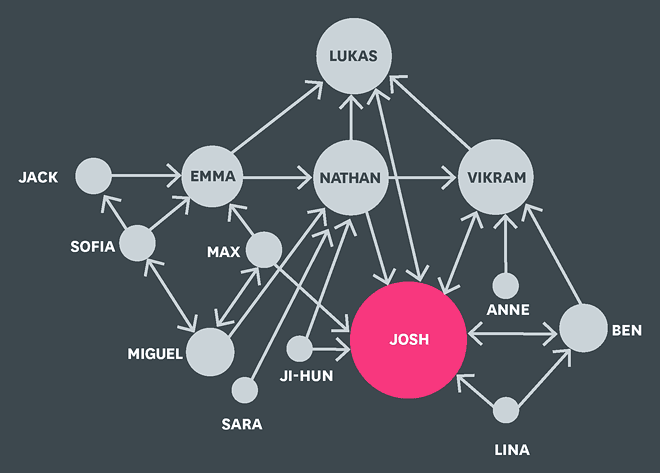
This month’s Harvard Business Review magazine features the topic of influence, both on how to both find it and gain it. Authors Julie Battilana & Tiziana Casciaro in their article “The Network Secrets of Great Change Agents” explore in depth how to overcome staunch resistance to change so common across large organizations by examining what master change experts do well.
Everyone is familiar with a company’s organizational chart. It lays out the formal hierarchy of authority in an organization, identifying who reports to whom for what and in effect summarizes the “pecking order” of formal status and formal power.
However, these formal organizational charts are not the most helpful tools in identifying sources of influence. Battilana & Casciaro suggest redrawing the traditional organization chart; highlight an individual’s influence in the organization by the size of their circle or box on the organization. What you’ll find is that the most influential people in the organization – the ones who hold sway or informal power over their colleagues and peers in terms of their opinion – are usually not at the top of the organization but dispersed lower down throughout the organization. No leader of any dramatic change can implement the change successfully in both the heads and hearts of his or her staff by sheer formal authority. That is simply not how dramatic changes become deeply embedded in an organization’s DNA.
Battilana & Casciaro suggest these individual influential circles come in 3 different shapes when trying to implement dramatic change throughout an organization:
Endorsers – they embrace the change easily and readily
Fence sitters – undecided as to whether they will support the change
Resisters – will not clearly support the change and are opposed to it
The authors propose that being close to endorsers will not hurt, but it won’t make them more engaged either. Fence sitters are critical and so invest personal time with them (taking them out to lunch, be genuine in your interest in their opinions and find similarities and common purpose to build goodwill). Resisters should be dealt with care. If the change is dramatic, they are not likely to come along.
These findings have implications for all organizations attempting major change. Let me attempt to apply this to turning around a school, taking it from the bottom 5% and transforming it into a student centered learning environment powered by personalized, data rich, internet enabled technology. I believe would fit the definition of a dramatic change.
1. Take your school’s formal organization chart. Redraw it by highlighting by the size of the individual circles the degree of influence they have on others. Highlight the networks teachers sit in and their degree of influence and cohesiveness within that network (i.e. a grade level team could be a natural cohesive network in place, or teachers with the same ethnic background, University alma mater, parenting life cycle stage, etc.).
2. For cohesive networks, get to the key influencer in that group to enlist their support and leadership in driving the change through their informal network.
3. For non-cohesive networks (i.e. teachers or administrative support that are not part of a cohesive group) you can be the bridge or link between these individuals where they begin to look to you to help influence their peers.
4. Identify the fence sitters and invest personal time with them, hearing their opinions and finding common ground.
5. Be wary of the resisters. They are not likely to come along for the ride and you may waste precious time and resources trying to convince them. If their resistance is particularly strong, consider replacing them.
One of the reasons Matchbook Learning seeks to turnaround bottom 5% public schools with our blended model is because we believe these children have the greatest need. One advantage of this approach is that these schools are in effect required by Federal School Improvement Grant guidelines to replace a majority (at least 50%) of their staff. This gives us an opportunity to interview incumbents to determine who simply does not buy into the vision of what we are trying to do and aggressively recruit those who do. We have found that we can build our turnaround efforts with both endorsers and fence sitters, but hard resisters are almost never won over to the degree our change strategy and the children we serve requires.
Now that we’ve covered how to find influence, next week we’ll take a look at a second article from the July/August 2013 issue of the Harvard Business Review on how to gain influence when it is not present.


